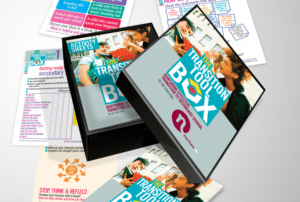The beginning of a new academic year means that children and young people will be making a transition, whether that is to a new year group or bigger moves such as Key Stage 2 to Key Stage 3 in Secondary school.
Whatever that move is, it is likely that it will involve changes in classes and teachers, possibly an increase in school size and staff numbers, different teaching styles and a broader curriculum. The social dynamics may also change and children may be faced with a more socially diverse population of young people if they are moving to Secondary Provision, for example.
Nurtureuk’s Six Principles of Nurture tell us that these transitions can be a significant stress for some pupils and that some of our more vulnerable children will need support and additional interventions prior to any changes. Dr Tina Rae, the author of The Transition Tool Box, explains that it is important that parents and school-based staff engage in the process of promoting resilience in children and young people, in all Key Stages and particularly in the stage of transition between Key Stages 2 and 3.
Tina Rae tells us that resilience is not about invulnerability but is essentially about our capacity to cope with whatever challenges life gives us. Continuous and extreme adversity is likely to drain even the most resilient children and adults. But when children are supported in developing a positive appraisal of themselves and think differently or in a more solution-focused way about events, they are then able to feel differently about their own competence. In essence, they believe in their own ability to cope.
She goes on to tell us that resilience is not something that people either have or don’t have; resilience can be taught, and as we learn we can increase the range of strategies available to us when things get difficult. In effect, the theory of resilience provides us with an optimistic message of hope. It is indeed possible to learn resilient thinking patterns and skills that in turn help us to become more accurate and flexible in our thinking and this is important given the fact that stress and adversity are an inevitable part of our lives.

Using Tina Rae’s Transition Tool Box, we have selected some activities to support transitions before your children or pupils go back to school, to prepare them for their new routines and new environment. We will be sharing these activities across our social media platforms over the coming weeks, so be sure to follow us on Facebook, Twitter, Linkedin or Instagram. The Transition Tool Box aims to promote teaching and learning opportunities that ensure the development of resilient children and young people who can cope effectively with the process of change. The resources all aim to promote pupil participation and ensure that wellbeing is further fostered and maintained for all children and young people. Although the toolbox is predominantly aimed at Y6/7, these cards are suitable for all age groups as they can be differentiated and adapted easily, depending on age or developmental stage.
As Tina Rae explains, if all adults involved in developing programmes of support for children and young people become further aware of the importance of developing resilience and the fact that resilience can be taught and further built on then, we can further support the development of resilience and ensure that our children or pupils develop the optimism and motivation necessary to cope with life’s setbacks and changes. We hope that this resource will enable school-based staff and parents to feel empowered to more appropriately and positively support the children and young people they nurture and care for – especially during times of transition.

